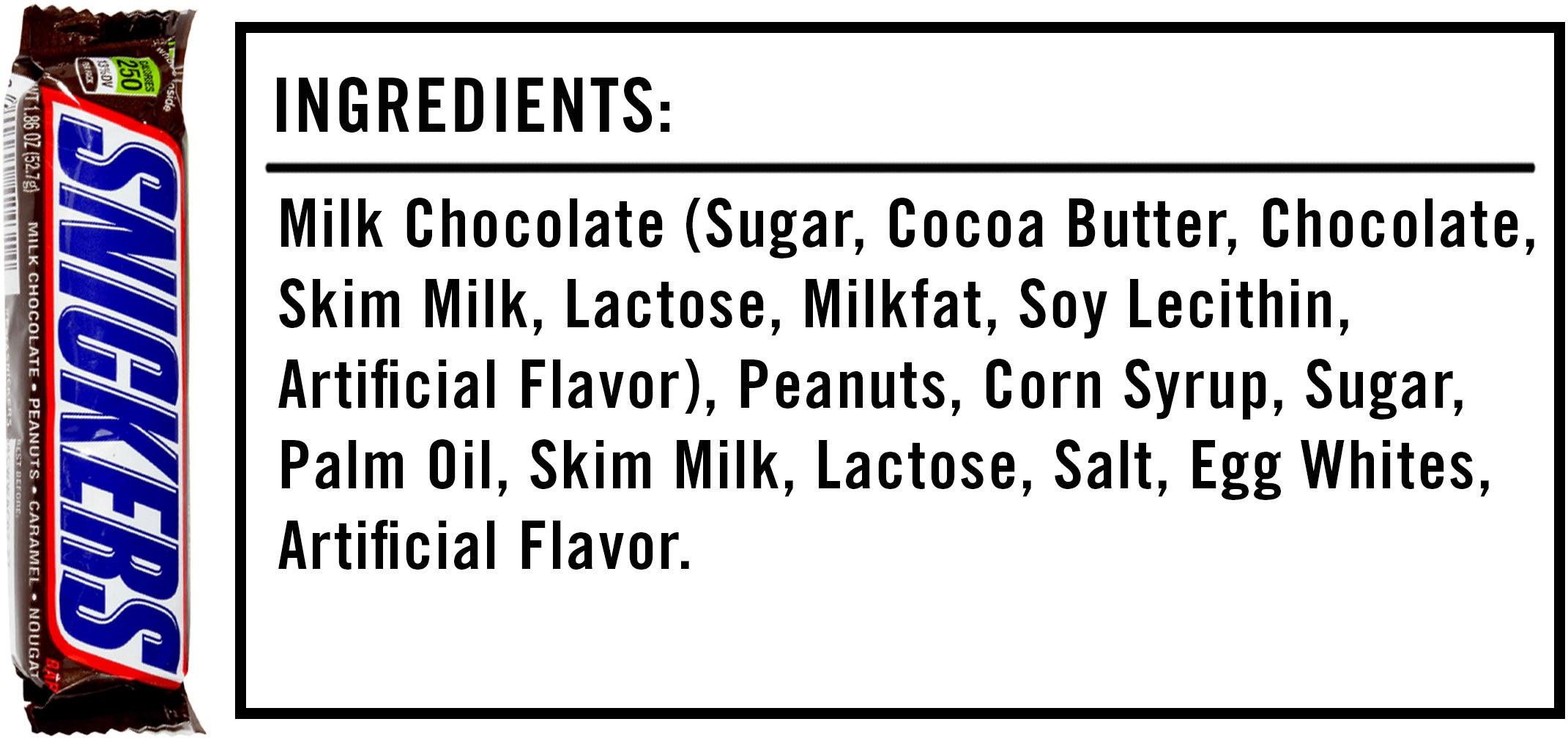We’re often told that you should never eat anything (or put anything on your body) if you don’t recognize everything on the ingredients list. But since most of us have no idea what xanthan gum or potassium benzoate are — or more importantly, what they’re doing to our bodies — we’re decoding the ingredients in the many things Americans put in (and on) themselves with the help of an expert.
This edition: Snickers, which are made from 10 separate ingredients (one of which has an ingredients list of its own) that we’ve broken down in the exact order they appear online.

The Ingredients
1) Milk Chocolate (Sugar, Cocoa Butter, Chocolate, Skim Milk, Lactose, Milkfat, Soy Lecithin, Artificial Flavor): Let’s take this one at a time, starting with sugar, which is abundant in Snickers. One bar contains 27 grams of sugar — that’s nearly seven teaspoons. For reference, the American Heart Association recommends men consume no more than 36 grams and women consume no more than 25 grams of added sugar a day (that doesn’t include sugar found naturally in foods like fruits and vegetables, either).
Next up: Cocoa butter, which is basically fat extracted from the cocoa bean. It’s used to make chocolate.
Then there’s skim milk, which is milk that’s had the cream removed. Skim milk also contains lactose, the sugar found in dairy. Speaking of milk, milkfat is the fatty portion of milk, and it’s usually added to processed foods as a means of adding heartiness and oftentimes a sort of creamy texture.
Moving on to soy lecithin, it’s a component of fat found in (you guessed it!) soy. It’s typically added to food products as an emulsifier. In simpler terms, it helps the numerous ingredients found in Snickers mix together. “It’s also frequently used to extend product shelf life,” Dagan Xavier, ingredient expert and co-founder of Label Insight, told me during our analysis of the ingredients in frozen breakfast sandwiches.
Finally, artificial flavors are chemical compounds created in a lab that mimic a natural flavor in some way. While that may sound unhealthy, as physician and biochemist Cate Shanahan, author of Deep Nutrition: Why Your Genes Need Traditional Food, told us during our exploration of all 26 ingredients in nacho-flavored Doritos, these flavorings are added in such small quantities that they shouldn’t cause you any harm.
2) Peanuts: The same nuts they serve at baseball games.
3) Corn Syrup: Corn syrup is a liquid sweetener made of glucose. It doesn’t get as much negative publicity as high fructose corn syrup — which has been linked to obesity and diabetes by many, many studies (more on that here) — but regular corn syrup can also be debilitating, considering it’s basically liquid sugar.
4) Sugar: See above.
5) Palm Oil: Shanahan previously told me that consuming too much vegetable oil — which is easy to do, considering she says roughly 45 percent of the average American’s calories come from refined oils — has serious repercussions (e.g., fatty liver disease, insulin resistance and migraines). While it’s near impossible to eliminate vegetable oil from your diet altogether — major contributors include processed foods, fried foods, frozen pizzas, cakes, cookies, margarines and coffee creamers — it’s best consumed in moderation. Worse yet, as we discovered during our recent ranking of cooking oils by how unhealthy they are, palm oil is one of the least healthy oils available.
6) Skim Milk: See above.
7) Lactose: Once again, see above.
8) Salt: For flavor.
9) Egg Whites: These are probably added to help thicken the chocolate in Snickers.
10) Artificial Flavor: Allow me to say it one more time: See above.
The Takeaway
As you might have expected, a Snickers bar is basically just sugar, sugar and a little more sugar. But hey, at least it’s got peanuts, right?

